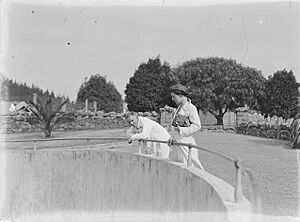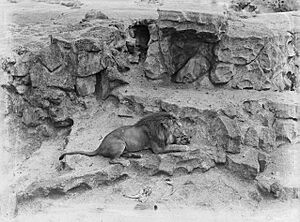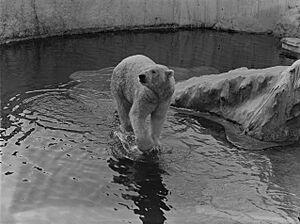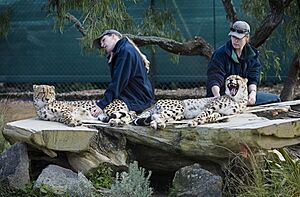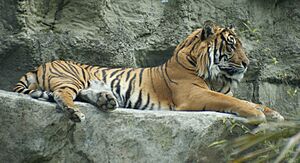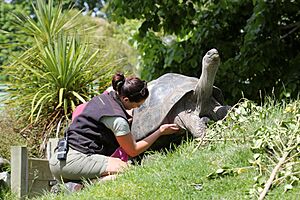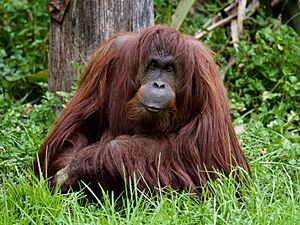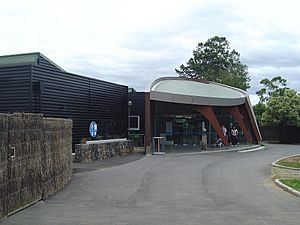Auckland Zoo facts for kids
 |
|
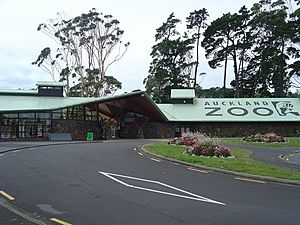
Zoo entrance on Motions Road
|
|
| Date opened | 16 December 1922 |
|---|---|
| Location | Western Springs, Auckland, New Zealand |
| Land area | 16.35 ha (40 acres) |
| Coordinates | 36°51′46″S 174°43′15″E / 36.86278°S 174.72083°E |
| No. of animals | 1,400+ |
| No. of species | 135 |
| Annual visitors | 716,327 (Jul 2012 – Jun 2013) |
| Memberships | ZAA |
| Major exhibits | Africa, Australia, Sri Lanka, South America, Te Wao Nui, KidZone |
Auckland Zoo (Māori: Rawhi Whakaaturanga o Tāmaki Makaurau) is a large zoological garden in Auckland, New Zealand. It covers about 16 hectares and is located next to Western Springs Park, close to Auckland's city center. The Auckland Council runs the zoo, with the Zoological Society of Auckland helping out.
Auckland Zoo first opened its doors in 1922. It faced some challenges early on, especially with keeping animals healthy. By 1930, the zoo had many animals and a special society was formed to support it. The zoo continued to grow after World War II. In the 1950s, chimpanzees used to have tea parties for visitors, but this fun practice stopped in 1964. The zoo expanded into the nearby Western Springs Park in 1973. Since the late 1980s, many old animal homes have been replaced with modern, natural-looking enclosures. In 2011, the zoo opened its biggest new area, Te Wao Nui, which showcases New Zealand's native plants and animals.
The zoo is divided into different areas based on where the animals come from, their type, or their natural environment. Auckland Zoo is very involved in protecting animals (especially New Zealand species), doing research, and teaching people about wildlife. It has modern facilities like the New Zealand Centre for Conservation Medicine (NZCCM), which helps sick animals.
Auckland Zoo is a full member of the Zoo and Aquarium Association (ZAA). It also received a special award in 2007 for its excellent environmental management system.
Contents
- History of Auckland Zoo
- How the Zoo Started
- The Early Years: 1920s
- Changes in the 1930s
- World War II Years: 1939–1945
- Post-War Growth: 1945–1949
- The 1950s: Shows and New Animals
- The 1960s: End of Tea Parties and New Arrivals
- The 1970s: Modernizing the Zoo
- The 1980s: Pandas and New Exhibits
- The 1990s: New Animals and Exhibits
- The 2000s: Births and Conservation
- The 2010s: New Developments and Departures
- Recent Events: 2020s
- Zoo Tracks and Habitats
- Auckland Zoo Centre for Conservation Medicine (AZCCM)
- Conservation Efforts
- Learning About Conservation
- Images for kids
- See also
History of Auckland Zoo
How the Zoo Started
The idea for Auckland's first zoo began in 1911 when a businessman named J.J. Boyd bought land in Onehunga to create a place for animals. Boyd had already started a small zoo near Wanganui in 1910.
Boyd's Onehunga Zoo often caused problems for the local council. Neighbors complained about the noise and smells. The council tried to close it many times. Eventually, new rules forced Boyd to close his zoo in 1922. The Auckland City Council bought the remaining animals from Boyd. These animals became the first residents of the new, permanent zoo at Western Springs.
The Early Years: 1920s
Auckland Zoo officially opened on Saturday, December 16, 1922. The Governor-General, Lord Jellicoe, and Auckland's mayor, James Gunson, were there. A large crowd came to see the new zoo. At that time, Western Springs was quite far from the city center, in a more rural area. People were very excited about the zoo because Boyd's earlier zoo had been well-known.
The zoo started with a basic setup. However, in 1923, staff quickly began planting 5,000 trees to make the grounds more beautiful. They also planned new homes for animals like polar bears, bison, and birds. Money was spent on building a bandstand, hippopotamus pools, an elephant house, and a tiger area.
L.T. Griffin was the zoo's first supervisor, like its first director. He traveled to Africa in 1923 to bring new animals to the zoo. The zoo grew quickly over the next few years. One of its first animal stars was Jamuna, a female Indian elephant. You can still see her influence today in the naming of Jamuna Plaza at the back of the modern zoo. In the early days, only two keepers worked seven days a week. Many animals died young, which was common for zoos at that time.
By December 1927, the zoo had 250 mammals of 80 different types, over 1000 birds of 130 types, and 24 reptiles of 6 types. Even with high animal deaths and a rat problem, the zoo was doing well. Popular animal homes were finished, and people continued to donate animals. In 1928, 25 mammals and 62 birds were born at the zoo, which was great news. By the end of the 1920s, the zoo was well-established with a large collection of animals. In 1929, the Auckland Zoological Society was formed to encourage scientific study.
Changes in the 1930s
In November 1930, the zoo welcomed its first male elephant, Rajah, from Hobart Zoo in Australia. Rajah was a large elephant, but after six years, his keeper found him hard to control. He was humanely put down. Rajah's skeleton is now on display at the Auckland War Memorial Museum.
In 1931, the number of animal deaths dropped a lot because their homes and care improved. L.T. Griffin, the first director, died in 1935. Lt. Col. E. R. Sawer, a former Director of Agriculture in Zimbabwe, became the new director. He believed that zoos should focus on education, science, and conservation. Sawer made many big changes, bringing more order and coordination to the zoo.
Under Sawer, the animal death rate dropped significantly. In 1937, only 9% of animals died, compared to 35% in 1930. By 1939, more mammals were being born than were dying. Sawer also improved animal diets with vitamins, which led to healthier animals and more successful breeding. He was also good at marketing and wanted more visitors. He pushed for an aquarium like the one that had boosted visitor numbers at the New York Zoo.
In 1938, a keeper named W.A. (Bill) Hawke was injured by a bear. He couldn't continue as a keeper but stayed at the zoo as a gatekeeper for 30 more years. Sawer also wanted to make it easier to bring in animals and to show native New Zealand birds. The end of the Great Depression helped Sawer transform the zoo from empty cages to a "full house of exhibits."
World War II Years: 1939–1945
During World War II, from 1939 to 1945, the zoo focused on just surviving. Fewer people visited, and it was hard to get new animals or enough food for them. Because of this, the zoo started to show more local and farm animals.
When United States soldiers arrived in New Zealand in 1942, many were stationed near Western Springs. This helped the zoo, as many soldiers visited on weekends. By the end of the war, the zoo was a bit run down and had fewer animals, but it was in good shape considering the difficult times. Many of the original zoo staff also retired during this period.
Post-War Growth: 1945–1949
After the war, Auckland Zoo still faced challenges. Zoos worldwide wanted to improve their collections, but New Zealand's isolated location made it hard to get animals. Also, Wellington Zoo seemed to get more support from politicians. Auckland Zoo was still not allowed to show native New Zealand animals.
However, 1948 was a turning point. New construction projects were approved. By March 1949, the zoo had 165 mammals (51 types), 329 birds (98 types), and 19 reptiles (8 types). A smaller aquarium was built, which was successful. The zoo finally won the right to show kiwi birds, partly because New Zealand soldiers were called "Kiwis" during the war. A curator's house, offices, and a laboratory were also built in 1949.
In late 1948, the council asked for animal shows. Sawer was strongly against this, but he was nearing retirement. Sawer wanted a full-time curator and veterinarian on site. His retirement marked the end of an important era. He had kept the zoo running well despite many difficulties. But the council had different ideas, leading the zoo to pursue animal entertainment.
The 1950s: Shows and New Animals
Robert W. Roach, an English veterinarian, became the zoo's curator in November 1949. Sawer stayed on as an assistant until July 1950. Roach started regularly opening new exhibits and even introduced postcards for the zoo. Over the next five years, the council spent more money on improving or building new homes for sun bears, wombats, echidnas, monkeys, tigers, and birds.
In 1954, the zoo experienced two tragedies. First, Albert Barnett, the zoo foreman, died from an infected finger injury. Then, in August, Frank Lane, who had worked at the zoo since it opened, was killed in an accident. Lane had just fed a young elephant, Kassala, when Jamuna, another elephant, accidentally knocked him into a wall with her trunk, killing him instantly. Jamuna had been upset after Barnett's death, who was her regular keeper. Lane's death was seen as a tragic accident. Jamuna lived the rest of her life without any more incidents.
Aucklanders now had more money and free time. Many people in their 30s and 40s had fond childhood memories of the zoo. In 1955, the council asked the zoo to get chimpanzees for performing shows. The zoo also added new attractions, like a miniature train. In September, two popular orangutans, Topsy and Turvey, arrived. Four young performing chimpanzees arrived from Regent's Park Zoo in October, and a chimpanzee performing area was quickly built. These chimps were named Jane, Josie, Minnie, and Bobby. Four more chimps joined them in 1959.
In June 1957, twin polar bear cubs were born, which was a special event. One cub died, but the other, Piwi, was healthy. However, Piwi drowned at eleven weeks old during a swimming lesson with its mother. A shocked crowd watched as Piwi died.
Roach resigned in 1958. During his time, the zoo's enclosures had improved, and basic hospital facilities, a quarantine area, and better equipment were created. Roach suggested many improvements, including expanding into Western Springs Park. The next two years saw the opening of a children's zoo.
The 1960s: End of Tea Parties and New Arrivals
In August 1960, Derek Wood from Chester Zoo became the new zoo supervisor. He brought a male giraffe named John from England's Regent's Park Zoo to start a new herd. Wood's first report in 1961 was positive. He suggested pairing animals, improving their homes, and building a nocturnal house for New Zealand's national bird, the kiwi. That year, 310,500 people visited the zoo. Also in 1961, a female elephant named Malini arrived from Singapore, becoming a long-awaited friend for Jamuna. Public feeding of animals continued, and problems with rats, eels, and flooding were still ongoing. The zoo's facilities were under pressure, and serious calls for expansion began.
A second group of four tea party chimpanzees arrived in 1959. By February 1963, the council admitted that the tea parties were becoming unsafe. However, they were popular and profitable. Wood was told to look into importing more chimpanzees. But changes in British laws and New Zealand Customs blocking an import permit finally ended the parties. The last one took place in May 1964. These chimpanzees showed unusual, anti-social behavior for the rest of their lives.
Nick died in 1961, followed by Minnie in 1964. Josie gave birth to a baby that died a few weeks later. Sissy gave birth to a female named Suzie, who keepers raised by hand. Sissy also had another daughter, Sally, in 1970. Suzie and Sally did not take part in the tea parties. They were later successfully introduced to a group of chimpanzees raised by their mothers, forming a natural social group. The tea party chimps stayed at the zoo until they died because they couldn't join the wild group in the 1980s. Janie, the last tea party chimp, died on October 11, 2013, at 60 years old.
Between 1962 and 1963, a strange skin problem affected the polar bears. Two adult males, Natuk and Brunus, and an adult female, Natasha, had to be put down. Natasha was the mother of Chimo, the only cub to survive to adulthood in the 70 years Auckland Zoo had polar bears. This period also saw many new animals arrive, including a pregnant zebra, a female giraffe named Anita, a pair of Bengal tigers, two young polar bears, a giant anteater, two capuchin monkeys, and four spider monkeys. The giraffe herd and spider monkey group at the zoo today are descendants of these animals.
Improvements to the zoo's buildings, exhibits, and processes were showing results. Old cages and aviaries were torn down, and new gardens were planted. The most important step was the council's 25-year plan. This plan included expanding into Western Springs Park and creating natural, moated, barless enclosures.
In September 1965, Jamuna, the zoo's famous elephant, died. She was thought to be about 50 years old and had carried over 750,000 visitors. Less than a year later, in May 1966, a visitor climbed over a safety barrier, and an orangutan named Turvey grabbed him through a bar and bit him. The man only had minor injuries because a keeper quickly helped him.
The next year, many new animals arrived again. These included Indian antelope, white-tailed deer, and Barbary sheep from Taronga Zoo. Also, 23 keas came from the South Island (two of which went to Dallas Zoo for three armadillos), 20 Australian lizards, and two black leopard cubs. In April 1968, Ma Schwe, a female elephant, arrived to replace Jamuna.
By the end of the 1960s, a long-term plan was in place for the zoo's management, animal collection, and grounds. The zoo's original entrance on Old Mill Road, used since 1922, was closed. A new side entrance opened on Motions Road.
The 1970s: Modernizing the Zoo
The early 1970s brought improvements to the zoo's grounds, exhibits, and animal care. Better veterinary practices and equipment, stopping public feeding (in 1979), and more natural-looking enclosures led to healthier, happier animals. This also meant more successful breeding.
Animals that weren't suitable for Auckland were moved to other zoos or gradually removed from the collection. During this time, keepers started providing "behavioral enrichment" for animals, which means giving them things to do that are natural for their species.
The NZI Kiwi Nocturnal House opened in May 1971. It was the first of its kind in New Zealand and is still open today as the BNZ Kiwi and Tuatara House. In August, the zoo finally got approval to expand by another 12 acres into Western Springs Park. Work began in 1973. Kashin, a female Indian elephant, arrived from Como Zoo in the US that same year. She lived at the zoo until her death in 2009. Two years later, the zoo hired its first full-time teacher.
A plan for a rural or open-range zoo was suggested to house and breed larger mammals. This idea has come up many times but has never happened. Also in 1976, the first full course for zookeepers started at the Auckland Technical Institute.
The late 1970s saw more developments at the zoo than ever before. A new gift shop, cafeteria, and enclosures for giraffes, zebras, and antelopes were completed. Animal diets were improved to today's high standards, where quality and varied ingredients are bought, and meals are carefully planned for each animal. White rhinoceros and tamarins arrived for the first time.
The 1980s: Pandas and New Exhibits
The 1980s started with a new hippo enclosure, the option to "adopt" an animal, and professional marketing for the zoo.
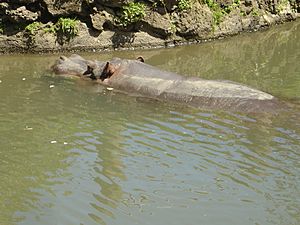
In 1981, the zoo's entrance moved to its current location off Motions Road (it has been updated since). Construction began on an improved animal hospital, which was finished in 1986. Fireworks in nearby Western Springs Park were banned after a giraffe named Lo Cecil died. A year later, the elephant Ma Schwe died suddenly from heart failure.
A larger Aquarium opened in 1982. However, fewer people started visiting the zoo. This was partly because new attractions like the Rainbow's End theme park and Kelly Tarlton's Underwater World opened in Auckland. The zoo's aquarium closed in December 2007.
In the mid-1980s, two chimpanzees, Mike and Lucy, arrived from Taronga Zoo. They joined Auckland's youngest chimps, Suzie and Sally. They moved into the old timber wolf exhibit, which was updated for them. Mike and Lucy had two babies, Lucifer in 1988 and Luka in 1993. This group of six apes stayed at the zoo until 2004.
In January 1987, a new orangutan exhibit opened. It was the zoo's most impressive and expensive exhibit at the time, designed with moats instead of bars. Visitor numbers started to go up again.
In 1981, three giraffes arrived from Honolulu Zoo: males Tsavo and Lo Cecil, and female Kinshasa. Another female, Manyara, followed in 1983. Kinshasa had her first baby, Kiri, in 1984, and a second, Kay, in 1986.
In 1986, the Chinese Government offered Australia a pair of giant pandas for a special loan. They stayed for three months in Melbourne Zoo and three months in Taronga Zoo, Sydney. Auckland Zoo quickly looked into having them visit too. The council agreed, and a special enclosure was built (which now holds a group of orangutans). The giant pandas, a four-year-old male named Xiao Xiao and a three-year-old female named Fei Fei, arrived at the zoo in October 1988 for a popular three-month visit. Over 300,000 people saw the giant pandas during their stay in New Zealand.
In March 1989, the first orangutan in New Zealand was born, a female named Intan. In May 1989, a male named Datuk was born. In December 1989, two California sea lion pups were born: Sleek and Kelp.
The 1990s: New Animals and Exhibits
The female Asian elephant Burma arrived in 1990 when she was eight years old. Construction soon began on the Elephant Clearing exhibit. This is a large enclosure with a modern elephant house and a pool where the elephants can completely go underwater.
In December 1991, two more California sea lion pups were born: Scuttles and Keel. In December 1993, Kipper was born. In the mid-1990s, Sleek and Kelp were sent overseas. Scuttles and Kipper are still alive today.
In June 1994, the orangutan Indra had her second baby, a male named Isim. Dara's six-year-old son, Datuk, left for Taronga Zoo in 1996. The last polar bears, Joachim and Ingrid, died in 1995. Their old exhibit, built in the 1920s, was torn down, and the zoo stopped keeping polar bears. Other animals the zoo stopped keeping in the 1990s included wombats, pumas, jaguars, and leopards.
In 1998, the zoo's lions, Ruby and Jade, moved out of their old pit for renovations. After big changes, including adding a pool, two-year-old Sumatran tiger siblings, Nisha and Malu, arrived from Wellington Zoo. Nisha was kept for breeding, while Malu was sent to Perth Zoo in 1999.
Pridelands opened in 1997. It included a new savannah exhibit for giraffes, springboks, zebras, and ostriches, plus a rhino exhibit and Lion Hill. A year later, it expanded to include a new hippopotamus exhibit and a chacma baboon exhibit. Hippos Snorkel, Faith, and Fudge were lifted by crane into their new home. After successfully breeding hippos for years, Auckland Zoo decided to gradually stop keeping them. They sent extra male hippos overseas and neutered their remaining male hippo, Fudge, in 1993. Snorkel died in 2010, while Faith (40) and Fudge (28) both died in 2017.
Male lions, Tonyi and Tombo, arrived from Philadelphia Zoo in 1998. Females, Kura and Sheeka, arrived in 1999 from the United States and Australia. They moved into the newly developed Lion Hill.
In 1999, the zoo's current rhino, Mandala, was joined by a ten-year-old male, Kruger; a 13-year-old female, Mzithi; and an 18-month-old female, Mbili. These three rhinos came from South Africa to improve the genetics of the southern white rhinoceros population in Australia and New Zealand. It was discovered that Mzithi, who was already a mother to Mbili, was 10 months pregnant when she arrived.
The 2000s: Births and Conservation
In April 2000, a ten-year-old Temminck's golden cat, Hari, arrived from Taronga Zoo. In January 2003, a two-year-old female, Hoi-An, joined him from Singapore Zoo. In March 2004, Hoi-An gave birth to twin males, Datan and Hotan. Datan was sent to Hamilton Zoo in 2005, and Hotan followed as a replacement after Datan's death. Hoi-An gave birth again in January 2005 to a single male cub, Saigon. After Hari's death in 2006, a new pair, Kuching and Singha, arrived from the Adelaide Zoo in 2008.
In June 2000, white rhino Mzithi gave birth to the zoo's first white rhino calf, and the first female white rhino born in New Zealand. The calf was named "Kito," meaning "precious" in Swahili. After Mzithi and Mbili died unexpectedly in September 2003, Kito was sent to Hamilton Zoo in January 2004 to learn social skills from their herd. In 2007, white rhino Mandala was put down due to health issues. Auckland Zoo then swapped rhinos: Kruger went to Hamilton Zoo for breeding, and Auckland received Hamilton's breeding male, Zambezi, and his sons, Inkosi and Mtoto.
In June 2000, the orangutan Dara gave birth to a daughter named Darli. Sadly, Dara became very sick and died the next day. Darli, who was weak, also died at just one day old. In mid-2001, three female orangutans, Wanita, Melur, and Gangsa, arrived from Taronga Zoo. Melur gave birth to a son, Madju, in November 2005. Horst, Indra, and their daughter Intan moved to Busch Gardens, Florida, in July 2009.
In November 2000, Asian small-clawed otter Jaya gave birth to three male pups. Her daughter, Jade, had five male pups in May 2001. All eight pups were fathered by Te'alc and were sent to other zoos when they grew up. Te'alc went to Wellington Zoo in late 2001. Jade was then paired with an older male, Nip. They had a litter in May 2002. In April 2003, Jade gave birth to four female pups. A new breeding male, Juno, arrived in 2008 and was paired with Jana. They had twin male pups in July 2009.
In December 2000, red panda Maya gave birth to female twins, Blaze and Amber. She had triplets in December 2002. Blaze left for Mogo Zoo in 2002, and in 2006, brothers Chico and Badal were sent to Hamilton Zoo. The zoo's breeding male, Shimla, died in 2006.
In May 2001, siamang gibbon Iuri gave birth to her fifth baby, a male named Irian. In March 2003, she had twins, the first born in Australia or New Zealand. The female baby, Iberani, was put down after her mother attacked and rejected her and her twin brother, Iwani. Iwani was later reunited with his family. He became the zoo's breeding male after Irian left for Adelaide Zoo in 2006 and his parents left for Hamilton Zoo in 2009. He was paired with a female, Kera, who arrived in October 2009.
In May 2001, three-year-old lioness Kura gave birth to four cubs, the first born at the zoo since the 1980s. In August 2001, two-year-old Sheeka gave birth to three female cubs. When the cubs were a year old, they were transferred to other zoos. In April 2003, male lions Tonyi and Tombo left for Melbourne Zoo. New males Lazerus and Ngala arrived from South Africa to join lionesses Kura, Sheeka, and Amira. In March 2004, Amira gave birth to two cubs, a male, Zulu, and a female, Zalika. In May 2004, Kura gave birth to four more cubs. All six cubs were fathered by Lazerus. In 2005, these cubs were also sent to other zoos.
In July 2001, a group of flamingo chicks arrived from the UK. They were raised by hand and flown to New Zealand. In September 2001, the Sea Lion and Penguin Shores opened. California sea lions moved into the new pool, and six little blue penguins moved into a nearby exhibit. The sea lion pool is a large, filtered saltwater tank with an underwater viewing window.
In September 2001, a male serval named Indlozi arrived from Germany. In April 2002, Mazimba gave birth to the first serval born in Australia or New Zealand in 10 years. The male kitten, Sika, had a small growth on his neck, which was successfully removed. Mazimba was sent to Australia in 2003, while Sika was transferred to Mogo Zoo. In 2003, a new female, Shey, arrived from South Africa. She gave birth to triplets in 2004. In 2008, Izazi gave birth, but the kittens did not survive.
In November 2002, giraffe Kiri gave birth to a male calf named Masamba. This was followed by a second male, Jabari, born to Kay in December 2002. These were the first calves born in eight years and the first to the new breeding male, Zabulu. A new female, Rukiaya, arrived from Wellington Zoo. Kiri died less than six months after Masamba's birth due to a leg injury. In 2004, Kay gave birth to her fourth calf, Ndale. She had her fifth calf, Dume, in 2006, and her sixth calf, Ntombi, in 2007. Ntombi was the first female calf to survive in 21 years. These calves were sent to other zoos. Rukiaya gave birth to her first calf in 2006, which died, and her second, Forrest, in 2007. Forrest was sent to Australia Zoo a year later.
In June 2004, the chimpanzee group, Suzie, Sally, Mike, Lucy, Luka, and Lucifer, were sent to Hamilton Zoo. The same year, Tea Party Chimp, Bobbie, died, leaving Janie as the last one.
In November 2005, a male New Zealand fur seal, Kaioko, arrived. He was later joined by a female, Moana, in June 2006, and a male Sub Antarctic fur seal, Orua, in August 2007.
In December 2005, zebra Shiloh gave birth to a male foal named Bakari, the first zebra born at the zoo since Shiloh's own birth in 1992. A second mare, Itika, arrived in 2006 and gave birth to a male foal named Carlo in December 2007. The zoo's breeding male, Monty, died in November 2007 and was replaced by Machono from Hamilton Zoo in 2008. Bakari and Carlo were sent to Keystone Wildlife Park that same year.
In April 2006, cheetah brothers, Anubis and Osiris, arrived from South Africa. They were raised by hand and participate in visitor encounters, often walked around the zoo daily.
In September 2007, Auckland Zoo opened the New Zealand Centre for Conservation Medicine (NZCCM). This was the first national center for conservation medicine in the world. It replaced the zoo's old vet center. The NZCCM has a public viewing gallery where visitors can watch into the lab, treatment room, and operating theater. Cameras above the operating table show surgeries on screens in the gallery. Researchers can also be seen working. The gallery has exhibits with animal specimens and information about diseases. The zoo explains conservation medicine as connecting human health with the health of animals and the environment.
In May 2006, Sumatran tigress Nisha died after a stroke. A month later, her intended mate, two-year-old Oz, arrived from Tel Aviv Zoo. Nisha's sister, Molek, was imported from Hamilton Zoo in September. After mating with Oz, she gave birth to triplets in June 2008. These two males, Jalur and Berani, and the female, Cinta, were the first Sumatran tigers born at Auckland Zoo.
In February 2007, porcupine Diablo arrived and moved into the meerkat enclosure. In January 2008, Auckland Zoo's first litter of meerkat pups was born to parents Umi and Mbembe. Several more pups have been born since.
In May 2009, Auckland Zoo decided to gradually stop keeping chacma baboons and focus on the hamadryas baboon, which are found in zoos throughout the region. Females Kito and Ayisha arrived from Wellington Zoo, and in June 2009, males Afar and Wasaro arrived from Adelaide Zoo. Ayisha was pregnant when she arrived and gave birth to a son named Yafeu in July 2009.
In August 2009, Kashin, the zoo's 41-year-old elephant, was put down due to ongoing health problems related to her arthritis. Kashin arrived at Auckland Zoo in 1972. A record 18,000 people came to celebrate her life on Sunday, August 29, 2009. This was the most visitors ever to visit the zoo in one day.
The 2010s: New Developments and Departures
In March 2010, giraffe Rukiya gave birth to her third calf, a son named Jelani. In December 2011, a new female, Kiraka, arrived from Taronga Zoo. Rukiya's fourth calf, Nakaru, was born in January 2012, and her fifth, Shira, in August 2013. Kiraka gave birth to her first calf, Mdomo, in November 2013. In May 2014, a new giraffe house was completed for the female giraffes to stay overnight. In April 2015, Rukiya had another daughter, Zuri.
In April 2010, Temminck's golden cat, Singha, gave birth to kittens that died shortly after birth. In June 2010, the father, Kuching, was put down after being diagnosed with cancer. The zoo decided to stop this species program in Australia and New Zealand.
In June 2010, Auckland Zoo opened the Tropics exhibit. This new area became home to the zoo's American alligator, Doris, who was 26 years old. She was soon joined by four new 8-year-old females. In November 2010, a male golden lion tamarin, Janeiro, arrived from Adelaide Zoo to be a companion for the zoo's female, Gabrielle.
In August 2010, zebra Itika gave birth to a foal, Unyazi. Stallion Machano was sent to Keystone Wildlife Park in 2012, and Carlo returned to the zoo as the new breeding male. He was joined by a female named Shamwari in November 2012. In March 2013, Unyazi was sent to Taronga Zoo.
In September 2010, eight-year-old female red panda Khosuva was sent to Darjeeling Zoo in northern India. She joined their breeding program, Project Red Panda, which aims to breed red pandas for release into the wild. In return, Auckland Zoo received a 10-year-old male red panda named Sagar to be paired with their female, Amber. Breeding between Sagar and Amber was not successful, but a new female, Bo, arrived from Melbourne Zoo in July 2012. Bo gave birth to a male cub named Pabu in December 2012 and twins in January 2014.
In October 2010, two-year-old Sumatran tigers, Jalur and Cinta, left for Symbio Wildlife Park in Australia. Their sibling, Berani, still lives at the zoo with his mother, Molek. In November 2013, Auckland Zoo sent their breeding male, Oz, to Hamilton Zoo. They received Molek's brother, Jaka, in exchange.
In April 2011, Auckland Zoo continued its success with breeding hamadryas baboons when Ayisha gave birth to a son, Sekani. Kito gave birth to a daughter, Naeemeh, in July 2011, and a son, Badi, in December 2012.
In September 2011, Auckland Zoo finished its largest project ever, Te Wao Nui. Te Wao Nui covers over a fifth of the zoo grounds and focuses entirely on showing visitors New Zealand's unique plants and animals. It has six parts or habitats: The Coast, The Islands, The Wetlands, The Night, The Forest, and The High Country.
In September 2012, the dominant male lion Lazerus left for Taronga Western Plains Zoo. The remaining male lion, Ngala, was put down on August 15, 2014, due to a ruptured ligament. Auckland Zoo currently has three female lions, Kura, Sheeka, and Amira, and does not plan to bring in a male soon.
In October 2013, Janie, the last remaining Tea-Party chimp, died at the age of 60. She had lived at Auckland Zoo for 57 years.
In November 2013, a new male serval Moholo arrived from Mogo Zoo. In April 2014, he was joined by a one-year-old female serval named Shani from Boise Zoo in the US.
In January 2014, two flamingo chicks successfully hatched. This was the first time a zoo had successfully bred from an entirely hand-reared flock in the world, and these were the first ever bred in Australia or New Zealand. One chick was put down in March 2014 due to health issues, but the other chick is healthy.
In February 2014, Auckland Zoo announced that they had successfully bred and raised twin lesser short-tailed bats, a species found only in New Zealand. The zoo was the first place in the world to breed and raise this species to adulthood in captivity. In March 2014, otters Juno and Jeta had two male pups.
In April 2014, Auckland Zoo opened a new exhibit for four Tasmanian devils. They arrived from Healesville Sanctuary in Australia as part of a special program to protect the species and raise awareness about these critically endangered marsupials.
In June 2014, Auckland Zoo hosted famous primatologist Jane Goodall. She met some of the zoo's native animals, including kea, tuatara, weta, and long-finned eels.
In January 2015, siamang gibbon Iwani was put down due to ongoing welfare issues. Iwani had been hand-raised from six weeks old after his mother rejected him. He was often agitated because he couldn't adjust to life as a siamang.
In April 2015, Auckland Zoo got two young female capybara (the world's largest rodents) from Adelaide Zoo. Their names are Rosita and Consuela. They share an enclosure with the squirrel monkeys in The Rainforest exhibit.
In March 2015, Auckland Zoo announced that 8-year-old Asian elephant Anjalee would be coming from Sri Lanka to be a companion for the lone elephant Burma. She spent a 3-month quarantine period on Niue before coming to Auckland. The zoo had been looking for an elephant companion for Burma since Kashin's death in August 2009.
In January 2016, the zoo celebrated the birth of two Nepalese red panda cubs. These cubs are a very important addition to the international breeding program for this endangered species. There was also a baby boom in the Rainforest, with three squirrel monkeys born.
In February 2016, the zoo celebrated new additions to the breeding and raising of New Zealand's rare Archey's frog. These are the world's most unique and endangered amphibians. Three Archey's frogs successfully changed into adults in December 2013. These breeding successes, the first of their kind, increased the zoo's Archey's frog population to 25.
In May 2016, giraffe Zuri, a one-year-old female, joined Wellington Zoo's two female giraffes in the African savannah.
In June 2016, two male capybara pups were born to Kosh (a male who arrived from Chester Zoo in late 2015) and mother Consuela. They were named Pepe and Pablo. The pups brought Auckland Zoo's capybara total to five. However, there are no longer any capybaras at the zoo.
In September 2016, male rhino Mtoto was flown and then driven to Altina Wildlife Park in Australia. A special crate transported the 1.7-tonne Mtoto.
In December 2016, Auckland Zoo's new $3.2 million 'Strangely Beautiful Australia' area opened. This area is inspired by the Murray–Darling basin region of Southeast Australia. It is home to giant stick insects, eastern long-necked turtles, redback spiders, lace monitors, and colorful Australian birds. These animals join the Tasmanian devils, red-necked wallabies, and emus to create a diverse Australian area. This development was the second part of the zoo's big 10-year development plan.
In January 2017, on New Year's Eve morning, Auckland Zoo welcomed twin giraffe calves born to 7-year-old mother, Kiraka. Twin giraffe births are extremely rare, with only about 30 documented cases worldwide. Sadly, the twins were born early and were quite light. The female calf could stand and feed early, but the male was very weak and could not function on his own or bond with Kiraka. Despite the hard work of the zoo teams, the male calf did not improve and was humanely put down. The female calf was named Kabili.
Also in January 2017, for only the second time in its history, Auckland Zoo welcomed a greater flamingo chick. The chick hatched on January 3. In 2014, the zoo made news for being the first in Australia and New Zealand to breed greater flamingo chicks. They were also the first zoo in the world to successfully breed from a flock that was entirely hand-raised. Auckland Zoo has a flock of greater flamingos, which is the only group of flamingos in Australia and New Zealand.
In February 2017, Auckland Zoo's young male giraffe Mtundu traveled to Sydney for a new life at Mogo Zoo.
In April 2017, the zoo's male Rothschild giraffe Zabulu had to be put down. Zabulu, who was 19 years old, had been unwell and got much worse the day before he died. This left Auckland Zoo with a herd of three female giraffes.
Recent Events: 2020s
As of November 12, 2024, the zoo's last Asian elephant, Burma, moved to Monarto Safari Park in Australia. She had lived at the zoo for many years.
Zoo Tracks and Habitats
Auckland Zoo is currently home to over 1,400 individual animals from 135 different species. It covers about 16 hectares. The zoo is divided into exhibition areas based on where the animals originally come from.
- Africa Safari Track – Here, you can see giraffes, plains zebras, and common ostriches all living together in one large enclosure. You first view them from a boardwalk above. Across from them, nyala, waterbuck, and southern white rhinoceros share another enclosure. There's also a large walk-through aviary with masked lovebirds, meerkats, Cape porcupines, and leopard tortoises. This area also has ground-level views of the giraffes and zebras at a watering hole. You can also find greater flamingos, hamadryas baboons, cheetahs, and servals. An African-themed cafe called 'The Watering Hole' is located near the lions and flamingos.
- Australia Bush Track – This track starts with a walk-through area where red-necked wallabies and emus live together. This leads to an aviary with rainbow lorikeets, red-tailed black cockatoos, and Gouldian finches. After the aviary, the path continues to an indoor room with lace monitors, redback spiders, social huntsman spiders, and goliath stick insects. This room leads out to an aviary with eastern water dragons and rainbowfish. It connects to a Tasmanian devil habitat and a brolga enclosure. You can also see a male sulphur-crested cockatoo named Captain here.
- South East Asia Jungle Track – Siamangs and Bornean orangutans live in large exhibits with many aerial pathways up to 25 meters high for them to climb. There's also a large, clear, climate-controlled tropical dome that feels like a hot, humid Indonesian swamp forest. It's home to Sunda gharials and other reptiles and fish like Asian arowanas. You'll also find exhibits for Sumatran tigers and Asian small-clawed otters.
- South America Rainforest Track – This area has natural-looking exhibits. It starts with a grand entrance featuring tarantulas, leading to a rainforest track. Here, you'll see different monkey species like black-handed spider monkeys, golden lion tamarins, and black-capped squirrel monkeys. This area also has American alligators, green iguanas, a group of cotton-top tamarins, and emperor tamarins. The renovated Galápagos tortoise exhibit is also here. Lizard Lane, with various lizard species like Cunningham's spiny-tailed skinks, eastern blue-tongued lizards, and sheltopusik, is also part of this area.
- Te Wao Nui – "Te Wao Nui" is a Māori-language phrase meaning "the living realm." It shows six different New Zealand environments: The Coast, The Islands, The Wetlands, The Night, The Forest, and The High Country. It's home to over 60 native New Zealand animal species, including a subantarctic fur seal, little penguins, Malherbe's parakeets, Antipodes parakeets, tuataras, New Zealand longfin eels, brown teals, North Island brown kiwi, morepork, Little Barrier giant wētā, kākā, kererū, North Island saddlebacks, tūī, kea, takahē, and blue ducks. The habitats also feature 110 different plant species native to New Zealand.
- Other animals – Other animals you can see at the zoo include ring-tailed lemurs, scarlet macaws, and red pandas.
Auckland Zoo Centre for Conservation Medicine (AZCCM)
The AZCCM opened on August 10, 2007. It was originally called the New Zealand Centre for Conservation Medicine. This $4.6 million facility is the first national center for conservation medicine in the world. Its operating theatre is visible to the public. Cameras above the operating table show surgeries on screens in the gallery. You can also watch researchers at work.
The viewing gallery has exhibits with different specimens, including preserved parts of animals that needed surgery and mounted small animals. It also provides information about how diseases can spread between humans and animals. You can even control microscopic images projected on a large screen. The zoo describes conservation medicine as "a practice that looks at the connections between our (human) health, the health of animals, and the environment."
Conservation Efforts
The Auckland Zoo Conservation Fund started in 2000. It provides money to help conservation projects in 12 key areas in New Zealand and overseas. The six New Zealand areas are: the Coast, the Islands, the Wetlands, the Night, the Forest, and the High Country. The six international areas are: Africa, Nepal, Pacific Islands, South America, Southeast Asia, and Sri Lanka. Auckland Zoo helps protect animals through breeding programs, education, speaking up for animals, and research. Zoo staff also go to help projects in New Zealand and other countries, sharing their special skills.
In July 2009, Auckland Zoo decided to stop selling Cadbury products in its shops and restaurant. This was because Cadbury started adding palm oil to their chocolate. Palm oil production harms rainforests in Southeast Asia, which are home to animals like the Sumatran tiger and orangutan. Wellington Zoo supported this decision. Many people on social media also supported boycotting Cadbury. After a lot of public pressure, Cadbury removed palm oil from its products the next month.
In September 2010, Auckland Zoo sent one of its female red pandas, Khosuva, to Darjeeling Zoo in northern India. She became part of a breeding program to help bring red pandas back to India's Singalalia National Park near Nepal. Any babies Khosuva has would be released into the wild to support Project Red Panda. This project works to connect isolated red panda populations along the India-Nepal border.
Learning About Conservation
The zoo helps teach school children about their own environment and the animal kingdom at the Discovery and Learning Centre. The zoo also offers special events like overnight stays and twilight tours (Safari Nights), as well as behind-the-scenes experiences.
The zoo also runs a Junior ZooKeeper program. This program lets children aged 6–13 years experience what it's like to be a zookeeper for a day. The program runs during school holidays. Activities include helping to clean, feed, and care for various zoo animals.
Images for kids
-
Auckland green gecko (Naultinus elegans)
See also
 In Spanish: Zoológico de Auckland para niños
In Spanish: Zoológico de Auckland para niños
- The Zoo (TV series)



